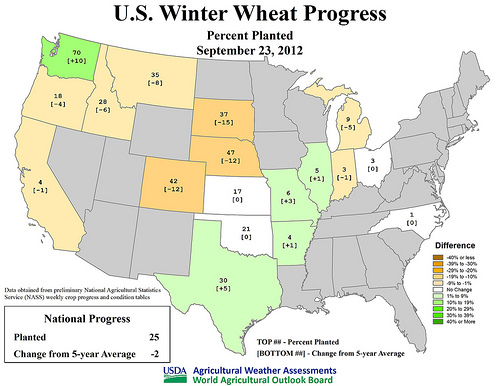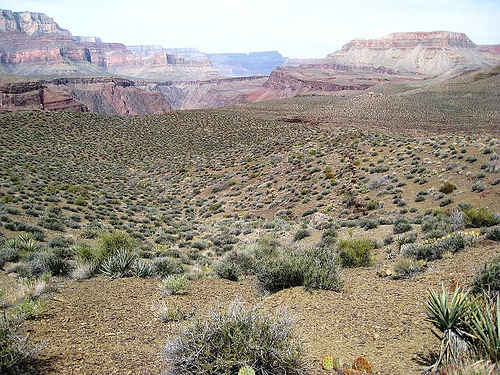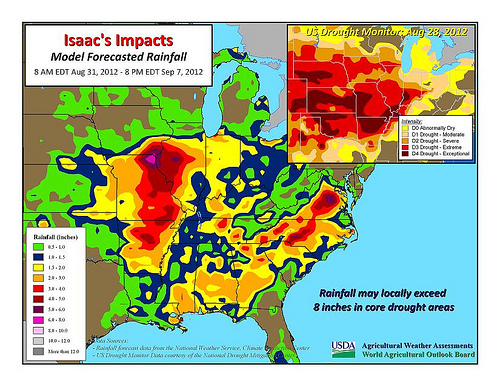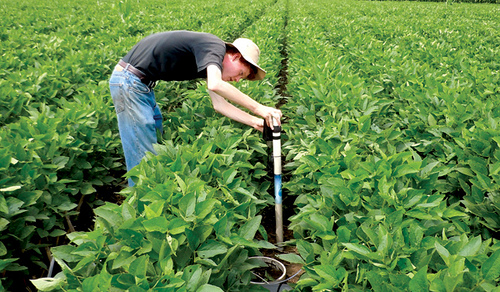
U.S. Winter Wheat Progress - Percent emerged September 30, 2012. Click to enlarge image.
Based on data since 1995, U.S. corn and soybean harvests are proceeding at a record pace. By September 30, 2012, more than one-half (54%) of the corn had been harvested, nearly three times the five-year average of 20%. During the preceding 17 years, the record amount of U.S. corn harvested by the end of September had been 35% in 2000. Similarly, 41% of the soybeans had been harvested by September 30. Prior to this year, the record-setting soybean harvest pace by September 30 had also been 35% in 2000. Read more »

U.S Winter Wheat Progress - Percent Planted as of September 23, 2012
Visit www.usda.gov/drought for the latest information regarding USDA’s Drought Disaster response and assistance.
Based on data since 1995, U.S. corn and soybean harvests are proceeding at a record pace. By September 23, more than one-third (39%) of the corn had been harvested, three times the five-year average of 13%. During the preceding 17 years, the record amount of U.S. corn harvested by September 23 had been 24% in 2000. Similarly, more than one-fifth (22%) of the soybeans had been harvested by September 23. Prior to this year, the record-setting soybean harvest pace by September 23 had been 18% in 2000. Read more »

Blackbrush, a species in the Mojave and Great Basin deserts, has adjusted well to climate change, according to genetics research by Forest Service scientists.
Climate change’s threat to forests – specifically to trees – has garnered much attention among people concerned with protecting our environment. Yet, a lack of research on the effects of climate change on grasslands and shrublands is leaving land managers with little information to make decisions on sustaining these vital landscapes so important for recreation, tribal life, crop and livestock production, and native plant and wildlife conservation.
Forest Service researchers point to recent climatic studies in predicting that by the end of the century, 55 percent of future landscapes in the West will likely have climates that are incompatible with the vegetation types that now occur on those landscapes. Read more »

Isaac's Impacts: Model Forecasted Rainfall, August 31, 2012. Click to enlarge image.
Visit www.usda.gov/drought for the latest information regarding USDA’s Drought Disaster response and assistance.
Hurricane Isaac has grabbed most of the weather headlines in recent days, but drought remains deeply entrenched across nearly two-thirds of the continental United States. According to the latest U.S. Drought Monitor, dated August 28, drought covered 62.9% of the Lower 48 states, down only slightly from a peak of 63.9% on July 24. However, during the five-week period from July 24 to August 28, the portion of the country in exceptional drought (D4) increased from 2.4 to 6.0%. Read more »

NIFA-funded grad student checks soil moisture gauge.
This post is part of the Science Tuesday feature series on the USDA blog. Check back each week as we showcase stories and news from USDA’s rich science and research profile.
Over the past decade, we’ve seen a lot of variability in the weather, with severe droughts in some places, excessive flooding in others, and more extreme weather events all over the country. While there has always been variability in the weather, scientists predict increasing variability in weather patterns as the concentration of greenhouse gases (GHG) increases in the atmosphere. Such changes present challenges for farmers, who, in many areas, are trying to grow crops under hotter, drier climate regimes and must protect their crops from damage during extreme weather events. That’s why the USDA is actively doing research on how to produce crops and livestock through increasing climate variability, and that’s why the fourth in a series of Office of the Chief Scientist white papers on the Department’s research portfolio is focused on what USDA science is doing to help prepare the agency, and the nation’s farmers for a changing climate. Read more »

Dr. Shirley Heymon-Parker and Dr. Ralph Nobel at at the North Carolina Agricultural & Technical State University in Greensboro, NC
Throughout the country, many schools and communities are teaching the importance of environmental stewardship, energy conservation, and reducing waste through innovation and creativity. I came across one of these places recently at North Carolina Agricultural & Technical State University in Greensboro, NC, the nation’s largest Historically Black College. Their School of Agriculture and Environmental Science has embraced the Obama Administration’s commitment to protecting the air we breathe, water quality, and land that supports and sustains us. Read more »






